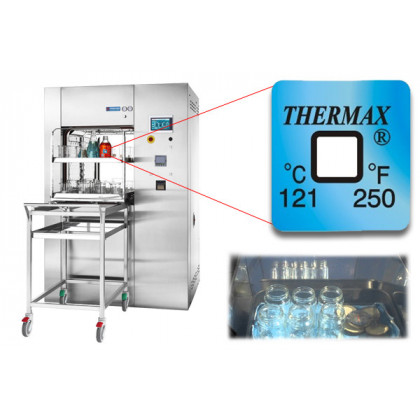Glassware sterilization is a process that refers to different types of containers, such as bottles, baby bottles, lunch boxes, trays and the like. In all cases, they must be carried out following guidelines that are designed to guarantee the best possible result.
Controlling the temperature in these processes is essential to ensure compliance. The temperature indicators are an affordable and reliable option in this case
How should the sterilization of glassware be carried out?
This will all depend on the type of item we need to sterilize. In the classification below, we comment on the characteristics of each type of sterilization.
Sterilization of laboratory glassware
Tubes, bottles and other material are usually sealed with cotton wool with waterproof paper placed on top. The following are commonly used for sterilization:
- Dry heat. The material must be exposed to fire directly, without the temperature exceeding 100 °C.
- Moist heat. Water at 100 °C is typically used for a maximum of 10 minutes.
- Steam. The ideal temperature is 121 °C for approximately 15 minutes.
Sterilization of glass food containers
They are usually sterilized by submerging them in boiling water at 100 °C and leaving them for 10 minutes. Then, they need to be dried, and you will be able to use them safely.
Temperature labels in glass sterilization
When using glass containers in the laboratory or catering business, regulations require them to be sterilized efficiently. Failing to do so may expose patients or clients to serious health consequences.
It should be noted that leaving a container in boiling water for longer than recommended could cause it to break. Also, we cannot always tell the exact temperature of the water, unless we have some sort of help.
Temperature labels, in this case, are a good solution since they adhere to the container easily and can withstand humidity and heat. Because they are stuck to the glass container, they guarantee that the temperature indicated is the heat the container has received. They include a temperature sensor that permanently changes colour when the marked temperature is reached. This guarantees that the exact temperature has been achieved to ensure correct sterilization.
These temperature indicators are an effective method for glassware sterilization quality control.
There are labels on the market that can measure temperatures in a wide range, so they can also be used to sterilize other materials like plastic.
Temperature indicators recommended in the control of glassware sterilization
Sterilization helps ensure that containers are continuously reused and, most of all, that all foods or drinks can be stored inside them once again. It is undoubtedly useful to avoid contamination through contact and to protect the preserved food better.
It should be noted that making sure the container is perfectly dry is extremely important. Otherwise, the tiniest amount of water could be the perfect habitat for microorganisms. If you are going to prepare jam or a similar product, you will have to repeat the process with the jar tightly closed to sterilize the outside of the container.
Glassware sterilization is, therefore, an obligation aimed at ensuring the healthiness of food stored in any kind of container. We always recommend the use of temperature labels. This will make the process much more reliable and will be the best guarantee of success.

